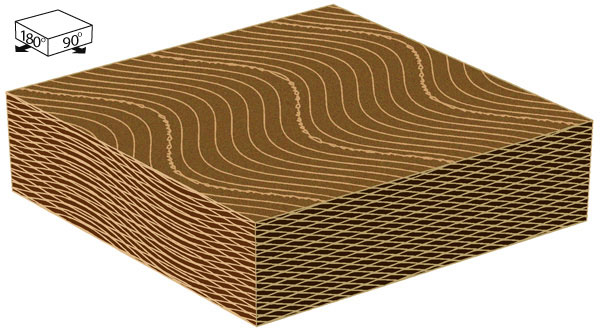Pacific Coastal and Marine Science Center
Bedform Sedimentology Site: “Bedforms and Cross-Bedding in Animation”


FIG. 32a. Structures formed by transverse bedforms with curved, in-phase crestlines: Fig. 32a (A) sine-shaped plan form, Fig. 32b (B) linguoid plan form, and Fig. 32c (C) lunate plan form.
RECOGNITION: The sinuous plan-forms of these bedforms cause the foresets that are produced to dip toward a wide range of directions. The cross-bed-dip plots consist of radial lines, because the direction of dip is constant throughout each vertical profile. The in-phase character of the crestlines, and the resulting lack of scour pits in the bedform troughs, cause the bounding surfaces that are scoured to be nearly planar. The slight curvature of the bounding surfaces results from the differing locations (in a downcurrent direction) at which the deepest point in the trough occurs. As the angle of climb approaches 08o9, bounding surfaces become more nearly planar. This structure is easily distinguished from bedforms with out-of-phase crestlines, because those bedforms have scour pits in their troughs and, as a result, produce trough-shaped sets of cross-beds (FIG. 34). The transverse orientation of these bedforms relative to the flow direction is indicated in horizontal sections by an absence of along-crest displacement of crestline sinuosities. In structures where such along-crest displacement is present, it is visible in sections parallel to the depositional surface (horizontal sections in Figs. 42-43). Such displacement also causes an asymmetrical distribution of dip directions of cross-beds and bounding surfaces that is visible in crest-parallel vertical sections and in plots of dip directions. Structures formed by transverse in-phase bedforms with sine- shaped, linguoid, and lunate crest plans are so similar that, except in unusually extensive horizontal sections, distinguishing their deposits is likely to be impossible. The wiggles in some of the cross-bed traces on the horizontal surface are not real. They are an artifact of the contouring program, and they are produced where the foresets are nearly horizontal.
ORIGIN: Bedforms with curved in-phase crestlines are relatively two-dimensional and could be expected to form in flows similar to those that produce two-dimensional bedforms. The specific hydraulic requirements for curved in-phase crestlines are not yet known.